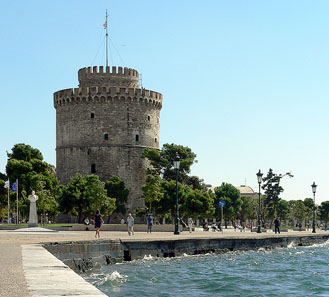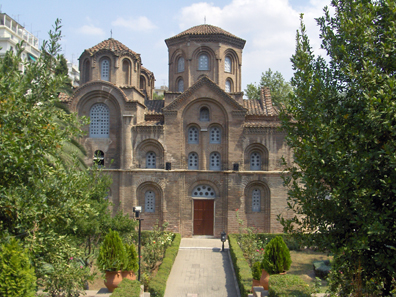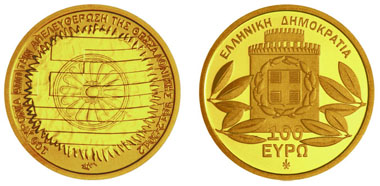December 6, 2012 – On November 5, 2012 the Bank of Greece has issued a commemorative coin which marks the centennial anniversary of the southern region of Macedonia and the city of Thessalonika coming under Greek sovereignty and union within the Modern Greek state. Thessalonika, a city rich in Hellenic culture and heritage, has a recorded history which spans more than 2,300 years.
The White Tower, part of the Byzantine fortifications. Photo: Zweifüssler / Wikipedia. http://creativecommons.org/licenses/by/2.0/deed.en
Founded in 315 BC by King Cassander of Macedonia (reigned 305-297 BC) the city grew to become one of the wealthiest and most important settlements within the Byzantine Empire and was often referred to as the second city within the Empire after Constantinople.
Thessalonika was besieged and captured by the Ottoman Turks in 1430 and for the next 400 years, remained as an administrative city within the Ottoman province of Rumelia (Rumeli Eyalet) Salonika was elevated to the status of a province (Selanik Vilayet) in its own right from 1826 to 1864 and in its final years under Ottoman rule, the city served as the capital of the Province of Greater Salonika (Vilâyet-i Selânik) from 1867 until its reunification with Greece in 1912. Thessalonika today is Greece’s second largest city and administrative regions.
Church Panagia Chalkeon, an eleventh century Byzantine church. One of 15 UNESCO World Heritage Sites in Thessalonika. Photo: Konstantinos Stampoulis / Wikipedia.
Its honourific title of Symprotévusa – literally translates to ‘co-capital’ with reference to its historical status as Symvasilévousa or the ‘co-reigning’ city within the Byzantine Empire, alongside Constantinople. Within the whole of the administrative region, the population is now more than one million people according to the 2011 census. Thessalonika is also home to numerous notable Greek, Roman, Byzantine and Ottoman monuments, which form now a UNESCO World Heritage Site.
Salonika is also one of the primary industrial cities with country and a major tourist destination for both Greeks and international travellers.
The coin, designed by artist-sculptor George Stamatopoulos, (widely known for his depictions on the one and two Euro Greek circulation coins) has included well-known images and symbols known in Salonika and all over Greece.
The obverse of the gold coin features a circular gold foil with a rosette at its centre, most probably the adornment of a garment (ancient cemetery of Nea Philadelphia, Thessaloniki, c. 480 BC), silhouetted against the Greek flag. The Greek text ‘100 years of the liberation of Thessaloniki 1912-2012’ is placed around the design along the upper half of the coin.
The reverse design includes one of the city’s most iconic symbols and structures of both Salonikan and Greek heritage, that of the White Tower, which is surrounded with sprigs of olive leaves on either side. Greece’s official crest is super-imposed over the tower. The text in Greek ‘Hellenic Republic’ is placed along the upper edge with the coin’s denomination of ‘100 Euro’ just below the primary design in two lines and the Greek Mint’s mintmark just below the denomination. Struck to superb proof quality in .916 fine gold (22 ct), the coin weighs 7.98 grams and has a diameter of 22.1 mm. A mintage of 1,500 pieces has been authorised.
For more information on this and other coins offered by the Bank of Greece, please visit their website.
A special e-mail address has been arranged for collectors outside of Greece. For information on ordering outside of Greece, please send an e-mail.






